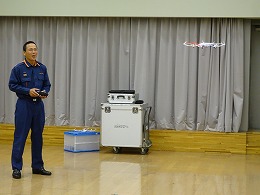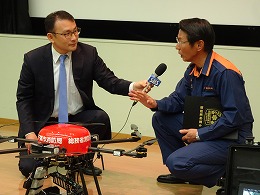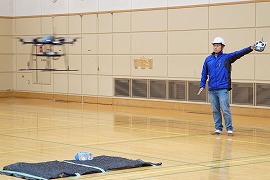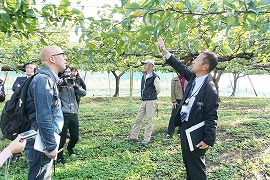実施日 : 2016年11月01日(火)
Report: Chiba Press Tour
投稿日 : 2016年12月13日
The FPCJ held a press tour covering the topic of the “industrial revolution of the skies” taking place in Japan, with visits to Autonomous Control Systems Laboratory (ACSL) which is working on practical applications for drones. The tour also visited the Chiba City Fire Department and a pear farm. This press tour was sponsored by Chiba Prefecture, with planning cooperation by the FPCJ.
Eleven journalists participated in the tour, from China, Singapore, South Korea, Taiwan, and the US.
-Click here for further details on the tour
-Click here for a log of real-time updates from during the tour
1) Chiba City Fire Department
The Chiba City Fire Department was provided with disaster-response drones by the Fire and Disaster Management Agency of the Ministry of Internal Affairs and Communications. Takayuki Mitsui, a member of the fire department, spoke about how the drones could be used, the training curriculum for drone operators, and the differences in functionality between standard hobby drones and the disaster-response drones. He explained how drones could be used to scout out areas with poisonous gas or other factors making it difficult for people to approach, and said, “There is no precedent for using drones to respond to disasters, so everything we are trying is tentative, but I feel like they will be quite useful.” Unfortunately, it was raining and so it was not possible to demonstrate the disaster-response drone, but the group was able to film and photograph a training drone being operated indoors.
The journalists asked questions including how long it took to train an operator for the disaster-response drone, the differences between operating the training drone and the disaster response drone, differences in functionality and uses between helicopters and drones, the cost of the disaster-response drone, and whether the drone was entirely made in Japan or not. Some of the journalists also mentioned their surprise at how small and compact the disaster-response drone was.



2) Autonomous Control Systems Laboratory
 Professor Kenzo Nonami, Japan’s leading authority on drone research, spoke about the latest research and business developments for drones. Professor Nonami explained that although China had a 60% share of the hobby drone market, Japan had an advantage in the field of industrial drones due to its advanced technology and trust in regards to safety. He also talked about how there were plans to begin deliveries in Chiba City using drones in 2019, so research was underway to prevent accidents caused by falling drones, by having the drones automatically determine where they would land and choose a safe spot. The professor commented, “I will continue to work towards creating a path towards a new industrial revolution by having drones make effective use of airspace 300 meters and lower, where manned vehicles do not fly.” Journalists asked a variety of questions: the possibility of using drones to help predict natural disasters, the cost in implementing drones for delivery, issues to be solved before the implementation of drones for industrial use in 2019, and what kind of drone functions he would like to develop.
Professor Kenzo Nonami, Japan’s leading authority on drone research, spoke about the latest research and business developments for drones. Professor Nonami explained that although China had a 60% share of the hobby drone market, Japan had an advantage in the field of industrial drones due to its advanced technology and trust in regards to safety. He also talked about how there were plans to begin deliveries in Chiba City using drones in 2019, so research was underway to prevent accidents caused by falling drones, by having the drones automatically determine where they would land and choose a safe spot. The professor commented, “I will continue to work towards creating a path towards a new industrial revolution by having drones make effective use of airspace 300 meters and lower, where manned vehicles do not fly.” Journalists asked a variety of questions: the possibility of using drones to help predict natural disasters, the cost in implementing drones for delivery, issues to be solved before the implementation of drones for industrial use in 2019, and what kind of drone functions he would like to develop.
Afterwards, the group filmed and photograph demonstration flights of three types of drones developed by ACSL, including a delivery drone, covering the unique technology of the company. Since it was raining, the demonstration took place indoors, but the journalists took plenty of photos and footage of the drones, with some of them also filming reports while there.



3) Takahashi Pear Farm
The tour visited Takahashi Pear Farm, where drones are used to monitor the farm. The weather had cleared up since the morning, and the journalists were able to film and photograph a drone flying outside while listening to an explanation from Mr. Akihiro Takahashi, who runs Takahashi Pear Farm. Mr. Akira Kitano of the Chiba Prefecture Agriculture, Forestry, and Fisheries Department then told the journalists about how Chiba is No. 1 in Japan for pear yield, output, and area cultivated, explaining pear cultivation technology and why the prefecture is suited to pear production. Mr. Takahashi spoke about the reasons behind using drones on his farm, and what functions he hoped to see carried out by drones. Journalists asked questions included how things were different before and after he started using drones, and what regulations they were for flying drones on the farm.






